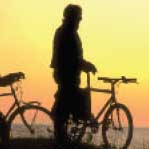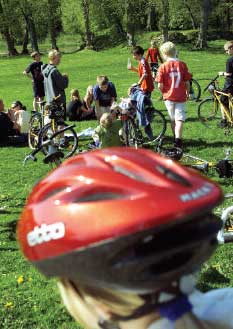|
| Front page | | Contents | | Previous | | Next |
Roads to Healthier Traffic
Roads to more physical exercise
It seems natural to integrate physical activity in everyday life. And to do so, the choice of means of transport plays a key role. When you choose to walk or take the bike, instead of
going by car, exercise comes naturally. The National Board of Health recommends 30 minutes of physical activity every day. Beside a number of direct positive consequences for you as
an individual, less car traffic will also benefit society as a whole, because fewer cars give less noise and less pollution.
There are numerous possibilities of integrating physical activity in your daily transport habits:
- go by bike or walk to work, to the supermarket, to the local store etc.
- walk to and from the bus, and get off one or two stops before your destination
- make a small detour when you cycle to and from work
- take the stairs at the railway or bus station, and everywhere else you go.
Places of work can also do something to reduce their employees' use of the car, for instance by making bicycles available, and by taking due consideration for health and the
environment when organising business trips.

Photo: BAM
The city of odense – good for bicycling
In the city of Odense, which has been appointed national cycle city in Denmark, great efforts have been made in recent years to improve
conditions for bicycling. Among the measures taken are good parking spaces for bicycles, extended nets of lanes and routes for cyclists, improved safety for bicycles at crossroads etc.
Cycles are allowed in pedestrian streets, traffic lights ensure green traffic waves for cyclists, and the municipality lends out bicycle trailers to families who take children to and from
daycare centres. Moreover, the municipality of Odense is running campaigns and organising events to promote cycling. It is estimated that the local efforts to improve conditions for
bicycling have increased transport by bicycle by 10-15 per cent.

Photo: BAM
| Front page | | Contents | | Previous | | Next | | Top |
Version 1.0 June 2004, © Danish Environmental Protection Agency
|